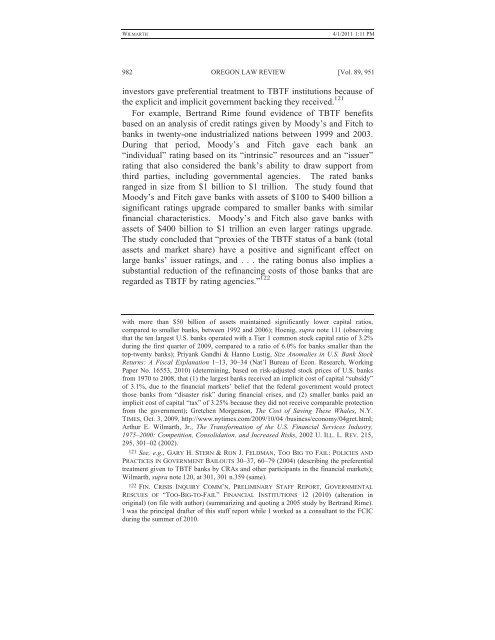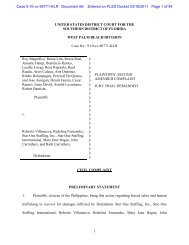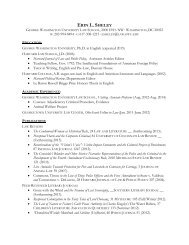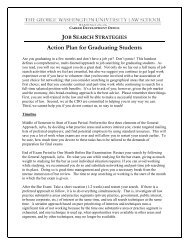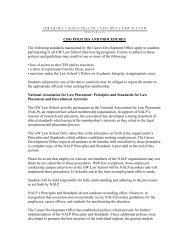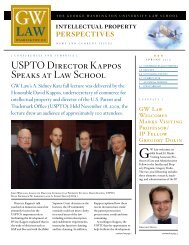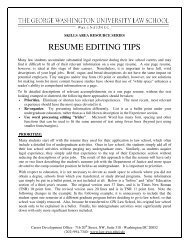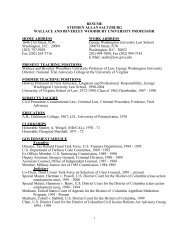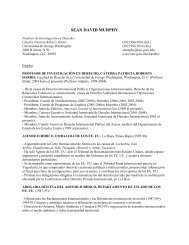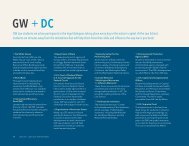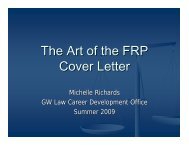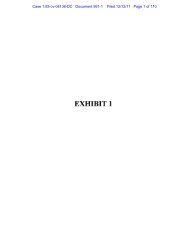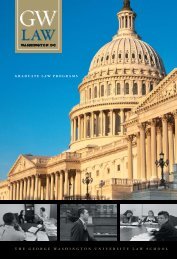CLE Materials for Panel #1 - George Washington University Law ...
CLE Materials for Panel #1 - George Washington University Law ...
CLE Materials for Panel #1 - George Washington University Law ...
You also want an ePaper? Increase the reach of your titles
YUMPU automatically turns print PDFs into web optimized ePapers that Google loves.
WILMARTH<br />
4/1/2011 1:11 PM<br />
982 OREGON LAW REVIEW [Vol. 89, 951<br />
investors gave preferential treatment to TBTF institutions because of<br />
the explicit and implicit government backing they received. 121<br />
For example, Bertrand Rime found evidence of TBTF benefits<br />
based on an analysis of credit ratings given by Moody’s and Fitch to<br />
banks in twenty-one industrialized nations between 1999 and 2003.<br />
During that period, Moody’s and Fitch gave each bank an<br />
“individual” rating based on its “intrinsic” resources and an “issuer”<br />
rating that also considered the bank’s ability to draw support from<br />
third parties, including governmental agencies. The rated banks<br />
ranged in size from $1 billion to $1 trillion. The study found that<br />
Moody’s and Fitch gave banks with assets of $100 to $400 billion a<br />
significant ratings upgrade compared to smaller banks with similar<br />
financial characteristics. Moody’s and Fitch also gave banks with<br />
assets of $400 billion to $1 trillion an even larger ratings upgrade.<br />
The study concluded that “proxies of the TBTF status of a bank (total<br />
assets and market share) have a positive and significant effect on<br />
large banks’ issuer ratings, and . . . the rating bonus also implies a<br />
substantial reduction of the refinancing costs of those banks that are<br />
regarded as TBTF by rating agencies.” 122<br />
with more than $50 billion of assets maintained significantly lower capital ratios,<br />
compared to smaller banks, between 1992 and 2006); Hoenig, supra note 111 (observing<br />
that the ten largest U.S. banks operated with a Tier 1 common stock capital ratio of 3.2%<br />
during the first quarter of 2009, compared to a ratio of 6.0% <strong>for</strong> banks smaller than the<br />
top-twenty banks); Priyank Gandhi & Hanno Lustig, Size Anomalies in U.S. Bank Stock<br />
Returns: A Fiscal Explanation 1–13, 30–34 (Nat’l Bureau of Econ. Research, Working<br />
Paper No. 16553, 2010) (determining, based on risk-adjusted stock prices of U.S. banks<br />
from 1970 to 2008, that (1) the largest banks received an implicit cost of capital “subsidy”<br />
of 3.1%, due to the financial markets’ belief that the federal government would protect<br />
those banks from “disaster risk” during financial crises, and (2) smaller banks paid an<br />
implicit cost of capital “tax” of 3.25% because they did not receive comparable protection<br />
from the government); Gretchen Morgenson, The Cost of Saving These Whales, N.Y.<br />
TIMES, Oct. 3, 2009, http://www.nytimes.com/2009/10/04 /business/economy/04gret.html;<br />
Arthur E. Wilmarth, Jr., The Trans<strong>for</strong>mation of the U.S. Financial Services Industry,<br />
1975–2000: Competition, Consolidation, and Increased Risks, 2002 U. ILL. L.REV. 215,<br />
295, 301–02 (2002).<br />
121 See, e.g., GARY H. STERN &RON J. FELDMAN, TOO BIG TO FAIL: POLICIES AND<br />
PRACTICES IN GOVERNMENT BAILOUTS 30–37, 60–79 (2004) (describing the preferential<br />
treatment given to TBTF banks by CRAs and other participants in the financial markets);<br />
Wilmarth, supra note 120, at 301, 301 n.359 (same).<br />
122 FIN. CRISIS INQUIRY COMM’N, PRELIMINARY STAFF REPORT, GOVERNMENTAL<br />
RESCUES OF “TOO-BIG-TO-FAIL” FINANCIAL INSTITUTIONS 12 (2010) (alteration in<br />
original) (on file with author) (summarizing and quoting a 2005 study by Bertrand Rime).<br />
I was the principal drafter of this staff report while I worked as a consultant to the FCIC<br />
during the summer of 2010.


